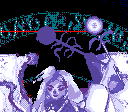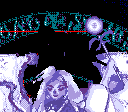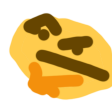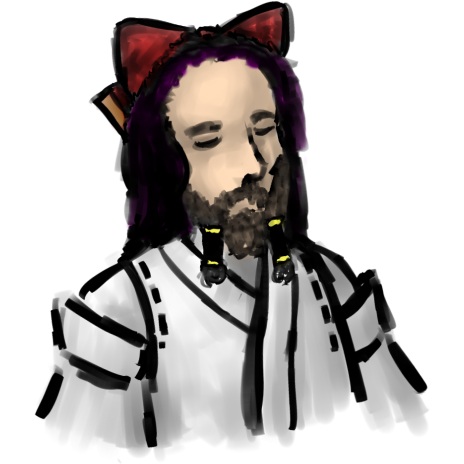- 📝 Posted:
- 🚚 Summary of:
- P0174, P0175, P0176, P0177, P0178, P0179, P0180, P0181
- ⌨ Commits:
27f901c...a0fe812,a0fe812...40ac9a7,40ac9a7...c5dc45b,c5dc45b...5f0cabc,5f0cabc...60621f8,60621f8...9e5b344,9e5b344...091f19f,091f19f...313450f- 💰 Funded by:
- Ember2528, Yanga
- 🏷 Tags:
Here we go, TH01 Sariel! This is the single biggest boss fight in all of PC-98 Touhou: If we include all custom effect code we previously decompiled, it amounts to a total of 10.31% of all code in TH01 (and 3.14% overall). These 8 pushes cover the final 8.10% (or 2.47% overall), and are likely to be the single biggest delivery this project will ever see. Considering that I only managed to decompile 6.00% across all games in 2021, 2022 is already off to a much better start!
So, how can Sariel's code be that large? Well, we've got:
- 16 danmaku patterns; including the one snowflake detonating into a giant 94×32 hitbox
- Gratuitous usage of floating-point variables, bloating the binary thanks to Turbo C++ 4.0J's particularly horrid code generation
- The hatching birds that shoot pellets
- 3 separate particle systems, sharing the general idea, overall code structure, and blitting algorithm, but differing in every little detail
- The "gust of wind" background transition animation
- 5 sets of custom monochrome sprite animations, loaded from
BOSS6GR?.GRC - A further 3 hardcoded monochrome 8×8 sprites for the "swaying leaves" pattern during the second form
In total, it's just under 3,000 lines of C++ code, containing a total of 8
definite ZUN bugs, 3 of them being subpixel/pixel confusions. That might not
look all too bad if you compare it to the
📝 player control function's 8 bugs in 900 lines of code,
but given that Konngara had 0… (Edit (2022-07-17):
Konngara contains two bugs after all: A
📝 possible heap corruption in test or debug mode,
and the infamous
📝 temporary green discoloration.)
And no, the code doesn't make it obvious whether ZUN coded Konngara or
Sariel first; there's just as much evidence for either.
Some terminology before we start: Sariel's first form is separated into four phases, indicated by different background images, that cycle until Sariel's HP reach 0 and the second, single-phase form starts. The danmaku patterns within each phase are also on a cycle, and the game picks a random but limited number of patterns per phase before transitioning to the next one. The fight always starts at pattern 1 of phase 1 (the random purple lasers), and each new phase also starts at its respective first pattern.
Sariel's bugs already start at the graphics asset level, before any code
gets to run. Some of the patterns include a wand raise animation, which is
stored in BOSS6_2.BOS:

The "lowered wand" sprite is missing in this file simply because it's
captured from the regular background image in VRAM, at the beginning of the
fight and after every background transition. What I previously thought to be
📝 background storage code has therefore a
different meaning in Sariel's case. Since this captured sprite is fully
opaque, it will reset the entire 128×128 wand area… wait, 128×128, rather
than 96×96? Yup, this lowered sprite is larger than necessary, wasting 1,967
bytes of conventional memory.
That still doesn't quite explain the
second sprite in BOSS6_2.BOS though. Turns out that the black
part is indeed meant to unblit the purple reflection (?) in the first
sprite. But… that's not how you would correctly unblit that?


Just like Konngara, Sariel continues the approach of using a single function
per danmaku pattern or custom entity. While I appreciate that this allows
all pattern- and entity-specific state to be scoped locally to that one
function, it quickly gets ugly as soon as such a function has to do more than one thing.
The "bird function" is particularly awful here: It's just one if(…)
{…} else if(…) {…} else if(…) {…} chain with different
branches for the subfunction parameter, with zero shared code between any of
these branches. It also uses 64-bit floating-point double as
its subpixel type… and since it also takes four of those as parameters
(y'know, just in case the "spawn new bird" subfunction is called), every
call site has to also push four double values onto the stack.
Thanks to Turbo C++ even using the FPU for pushing a 0.0 constant, we
have already reached maximum floating-point decadence before even having
seen a single danmaku pattern. Why decadence? Every possible spawn position
and velocity in both bird patterns just uses pixel resolution, with no
fractional component in sight. And there goes another 720 bytes of
conventional memory.
Speaking about bird patterns, the red-bird one is where we find the first
code-level ZUN bug: The spawn cross circle sprite suddenly disappears after
it finished spawning all the bird eggs. How can we tell it's a bug? Because
there is code to smoothly fly this sprite off the playfield, that
code just suddenly forgets that the sprite's position is stored in Q12.4
subpixels, and treats it as raw screen pixels instead.
![]() As a result, the well-intentioned 640×400
screen-space clipping rectangle effectively shrinks to 38×23 pixels in the
top-left corner of the screen. Which the sprite is always outside of, and
thus never rendered again.
As a result, the well-intentioned 640×400
screen-space clipping rectangle effectively shrinks to 38×23 pixels in the
top-left corner of the screen. Which the sprite is always outside of, and
thus never rendered again.
The intended animation is easily restored though:
Also, did you know that birds actually have a quite unfair 14×38-pixel hitbox? Not that you'd ever collide with them in any of the patterns…
Another 3 of the 8 bugs can be found in the symmetric, interlaced spawn rays
used in three of the patterns, and the 32×32 debris "sprites" shown at their endpoint, at
the edge of the screen. You kinda have to commend ZUN's attention to detail
here, and how he wrote a lot of code for those few rapidly animated pixels
that you most likely don't
even notice, especially with all the other wrong pixels
resulting from rendering glitches. One of the bugs in the very final pattern
of phase 4 even turns them into the vortex sprites from the second pattern
in phase 1
during the first 5 frames of
the first time the pattern is active, and I had to single-step the blitting
calls to verify it.
It certainly was annoying how much time I spent making sense of these bugs,
and all weird blitting offsets, for just a few pixels… Let's look at
something more wholesome, shall we?
So far, we've only seen the PC-98 GRCG being used in RMW (read-modify-write) mode, which I previously 📝 explained in the context of TH01's red-white HP pattern. The second of its three modes, TCR (Tile Compare Read), affects VRAM reads rather than writes, and performs "color extraction" across all 4 bitplanes: Instead of returning raw 1bpp data from one plane, a VRAM read will instead return a bitmask, with a 1 bit at every pixel whose full 4-bit color exactly matches the color at that offset in the GRCG's tile register, and 0 everywhere else. Sariel uses this mode to make sure that the 2×2 particles and the wind effect are only blitted on top of "air color" pixels, with other parts of the background behaving like a mask. The algorithm:
- Set the GRCG to TCR mode, and all 8 tile register dots to the air color
- Read N bits from the target VRAM position to obtain an N-bit mask where all 1 bits indicate air color pixels at the respective position
- AND that mask with the alpha plane of the sprite to be drawn, shifted to the correct start bit within the 8-pixel VRAM byte
- Set the GRCG to RMW mode, and all 8 tile register dots to the color that should be drawn
- Write the previously obtained bitmask to the same position in VRAM
Quite clever how the extracted colors double as a secondary alpha plane, making for another well-earned good-code tag. The wind effect really doesn't deserve it, though:
- ZUN calculates every intermediate result inside this function over and over and over again… Together with some ugly pointer arithmetic, this function turned into one of the most tedious decompilations in a long while.
- This gradual effect is blitted exclusively to the front page of VRAM,
since parts of it need to be unblitted to create the illusion of a gust of
wind. Then again, anything that moves on top of air-colored background –
most likely the Orb – will also unblit whatever it covered of the effect…

As far as I can tell, ZUN didn't use TCR mode anywhere else in PC-98 Touhou. Tune in again later during a TH04 or TH05 push to learn about TDW, the final GRCG mode!
Speaking about the 2×2 particle systems, why do we need three of them? Their only observable difference lies in the way they move their particles:
- Up or down in a straight line (used in phases 4 and 2, respectively)
- Left or right in a straight line (used in the second form)
- Left and right in a sinusoidal motion (used in phase 3, the "dark orange" one)
Out of all possible formats ZUN could have used for storing the positions and velocities of individual particles, he chose a) 64-bit / double-precision floating-point, and b) raw screen pixels. Want to take a guess at which data type is used for which particle system?
If you picked double for 1) and 2), and raw screen pixels for
3), you are of course correct! ![]() Not that I'm implying
that it should have been the other way round – screen pixels would have
perfectly fit all three
Not that I'm implying
that it should have been the other way round – screen pixels would have
perfectly fit all three systems use cases, as all 16-bit coordinates
are extended to 32 bits for trigonometric calculations anyway. That's what,
another 1.080 bytes of wasted conventional memory? And that's even
calculated while keeping the current architecture, which allocates
space for 3×30 particles as part of the game's global data, although only
one of the three particle systems is active at any given time.
That's it for the first form, time to put on "Civilization
of Magic"! Or "死なばもろとも"? Or "Theme of 地獄めくり"? Or whatever SYUGEN is
supposed to mean…
… and the code of these final patterns comes out roughly as exciting as
their in-game impact. With the big exception of the very final "swaying
leaves" pattern: After 📝 Q4.4,
📝 Q28.4,
📝 Q24.8, and double variables,
this pattern uses… decimal subpixels? Like, multiplying the number by
10, and using the decimal one's digit to represent the fractional part?
Well, sure, if you really insist on moving the leaves in cleanly
represented integer multiples of ⅒, which is infamously impossible in IEEE
754. Aside from aesthetic reasons, it only really combines less precision
(10 possible fractions rather than the usual 16) with the inferior
performance of having to use integer divisions and multiplications rather
than simple bit shifts. And it's surely not because the leaf sprites needed
an extended integer value range of [-3276, +3276], compared to
Q12.4's [-2047, +2048]: They are clipped to 640×400 screen space
anyway, and are removed as soon as they leave this area.
This pattern also contains the second bug in the "subpixel/pixel confusion
hiding an entire animation" category, causing all of
BOSS6GR4.GRC to effectively become unused:
At least their hitboxes are what you would expect, exactly covering the
30×30 pixels of Reimu's sprite. Both animation fixes are available on the th01_sariel_fixes
branch.
After all that, Sariel's main function turned out fairly unspectacular, just
putting everything together and adding some shake, transition, and color
pulse effects with a bunch of unnecessary hardware palette changes. There is
one reference to a missing BOSS6.GRP file during the
first→second form transition, suggesting that Sariel originally had a
separate "first form defeat" graphic, before it was replaced with just the
shaking effect in the final game.
Speaking about the transition code, it is kind of funny how the… um,
imperative and concrete nature of TH01 leads to these 2×24
lines of straight-line code. They kind of look like ZUN rattling off a
laundry list of subsystems and raw variables to be reinitialized, making
damn sure to not forget anything.
Whew! Second PC-98 Touhou boss completely decompiled, 29 to go, and they'll only get easier from here! 🎉 The next one in line, Elis, is somewhere between Konngara and Sariel as far as x86 instruction count is concerned, so that'll need to wait for some additional funding. Next up, therefore: Looking at a thing in TH03's main game code – really, I have little idea what it will be!
Now that the store is open again, also check out the 📝 updated RE progress overview I've posted together with this one. In addition to more RE, you can now also directly order a variety of mods; all of these are further explained in the order form itself.
